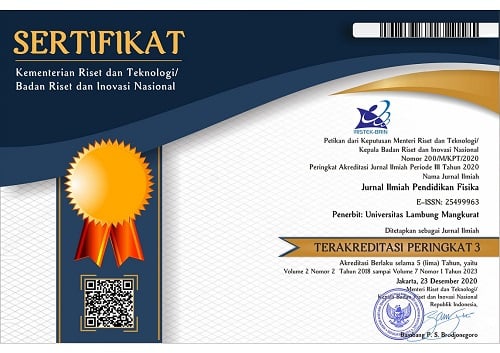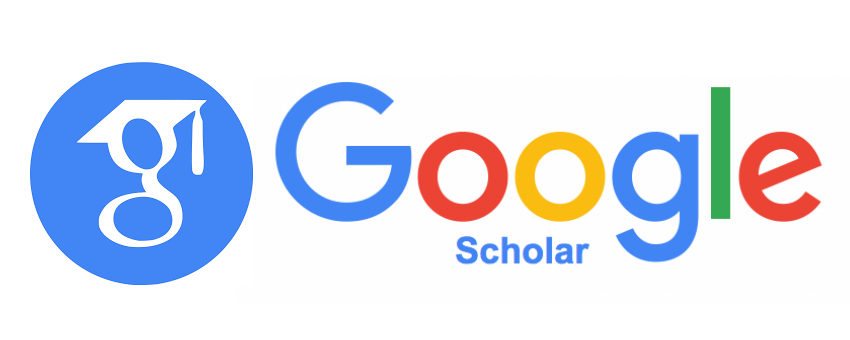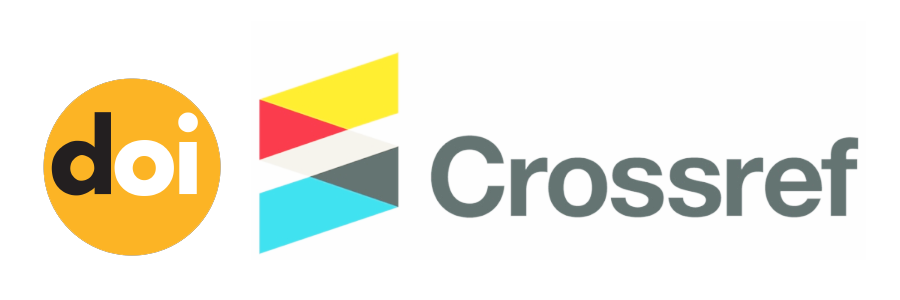An Analysis of Students’ Scientific Literacy Ability on Vibration and Wave Materials
Abstract
This study aims to describe students' scientific literacy skills on vibration and wave material at SMP Negeri 14 Pontianak and examine differences in abilities in each aspect of scientific literacy. The research method used is described with a quantitative approach. The research instrument was used in the form of test questions in the form of essays consisting of 15 questions based on scientific literacy. The sample in this study was class IX students at SMP Negeri 14 Pontianak, totalling 174 people. The measured scientific literacy includes aspects of science content, scientific processes, and the context of science. The results of data analysis showed that the scientific literacy ability of students of vibration and wave material was 33.70% for the science content aspect, 44.60% for the science process aspect, and 42.00% for the science context aspect. Based on the Kruskall-Wallis test, the results of the analysis showed that there were differences in the abilities of students in every aspect of scientific literacy. It is hoped that other researchers can apply science learning that focuses on aspects of science content.
Keywords
Full Text:
PDFReferences
Ahmad, A., Enawaty, E., & Lestari, I. (2018). Deskripsi kemampuan literasi sains siswa kelas xii ipa 1 di sma mujahidin pontianak pada materi. Prosiding Universitas Tanjungpura, 1–13.
Azizah, R., Yuliati, L., & Latifah, E. (1977). Kesulitan pemecahan masalah fisika pada siswa SMA. Postgraduate Medical Journal, 53(620), 343–344. https://doi.org/10.1136/pgmj.53.620.343
Chen, J., Zhang, Y., Wei, Y., & Hu, J. (2021). Discrimination of the contextual features of top performers in scientific literacy using a machine learning approach. Research in Science Education, 51, 129-158.
Dewantara, D., Mahtari, S., Misbah, M., & Haryandi, S. (2019). Student responses in biology physics courses use worksheets based on scientific literacy. Prisma Sains: Jurnal Pengkajian Ilmu Dan Pembelajaran Matematika Dan IPA IKIP Mataram, 7(2), 192-197.
Fatmawati, I. N. (2016). Penerapan levels of inquiry untuk meningkatkan literasi sains siswa smp tema limbah dan upaya penanggulangannya. Edusains, 7(2), 151–159. https://doi.org/10.15408/es.v7i2.1750
Fuadi, H., Robbia, A. Z., & Jufri, A. W. (2020). Analisis faktor penyebab rendahnya kemampuan literasi sains peserta didik. Jurnal Ilmiah Profesi Pendidikan, 5(2), 108–116.
Harlina, H., Ramlawati, R., & Rusli, M. A. (2020). Deskripsi kemampuan literasi sains peserta didik kelas ix di smpn 3 makassar. Jurnal IPA Terpadu, 3(2), 96–107.
https://doi.org/10.35580/ipaterpadu.v3i2.12320
Hartini, S., Latifah, R., Salam, M. A., & Misbah, M. (2019). Developing of physics teaching material based on scientific literacy. Journal of Physics: Conference Series, 1171(1), 012021. IOP Publishing.
Hewi, L., & Shaleh, M. (2020). Refleksi hasil PISA (The Programme For International Student Assesment): Upaya perbaikan bertumpu pada pendidikan anak usia dini. Jurnal Golden Age, 4(01), 30–41. https://doi.org/10.29408/jga.v4i01.2018
Ibrahim, M. A., & Aspar, N. H. M. (2011). Tahap Literasi Sains Di Kalangan Pelajar Tingkatan Empat. 2, 102–112.
Lestari, P. C., Miriam, S., & Misbah, M. (2021). Science literacy-based sound wave e-worksheet: Validity aspects. Journal of Physics: Conference Series, 2104(1), 012010. IOP Publishing.
Mahtari, S., Misbah, M., & Suryati, S. (2019). Analysis of the ability of High school students in solving science literacy questions based on the rasch model. Kasuari: Physics Education Journal (KPEJ), 2(1), 11-16.
McFarlane, D. A. (2013). Understanding the challenges of science education in the 21st century: New opportunities for scientific literacy. International Letters of Social and Humanistic Sciences, 4, 35–44. https://doi.org/10.18052/www.scipress.com/ilshs.4.35
Nofiana, M. (2017). Profil kemampuan literasi sains siswa smp di kota purwokerto ditinjau dari aspek konten, proses, dan konteks sains. JSSH (Jurnal Sains Sosial Dan Humaniora), 1(2), 77. https://doi.org/10.30595/jssh.v1i2.1682
Nugraheni, N. C. (2017). Kemampuan literasi sains kelas x SMA negeri mata pelajaran biologi berdasarkan topografi wilayah gunungkidul. Jurnal Prodi Pendidikan Biologi, 6(5), 261–272.
OECD. (2016). OECD.org-OECD. Organisation for Economic Co-Operation and Development.
Osborne, J. (2007). Engaging young people with science: Thoughts about future direction of science education. Promoting scientific literacy: Science education research in transaction.
Pantiwati, Y., & Husamah. (2016). Analisis literasi sains siswa smp kota malang. Prosiding Konferensi Ilmiah Tahunan., 48–64.
Pertiwi, U. D., Atanti, R. D., & Ismawati, R. (2018). Pentingnya literasi sains pada pembelajaran ipa smp abad 21. Indonesian Journal of Natural Science Education (IJNSE), 1(1), 24–29. https://doi.org/10.31002/nse.v1i1.173
Rohmah, I. L., & Hidayati, S. N. (2021). Analisis literasi sains peserta didik smpn 1 gresik. Pensa E-Jurnal : Pendidikan Sains, 9(3), 363–369.
Sani, R. A. (2021). Pembelajaran berorientasi akm asesmen kompetensi minimum. Bumi Aksara.
Sholikah, L., & Pertiwi, F. N. (2021). Analysis of science literacy ability of junior high school students based on Programme for International Student Assessement (PISA). INSECTA: Integrative Science Education and Teaching Activity Journal, 2(1), 95-104.
Sinaga, P., Kaniawati, I., & Setiawan, A. (2017). Improving secondary school students' scientific literacy ability through the design of better science textbooks. Journal of Turkish Science Education, 14(4), 92-107.
Subaidah, T., Muharrami, L. K., Rosidi, I., & Ahied, M. (2019). Analisis kemampuan literasi sains pada aspek konteks dan knowledge menggunakan cooperative proplem solving (cps) dengan strategi heuristik. Natural Science Education Research, 2(2), 113–122. https://doi.org/10.21107/nser.v2i2.6238
Suciati, Resty, W, Ita., Itang, Eskatur, N., Meikha, Prima, & Reni. (2016). Identifikasi kemampuan siswa dalam pembelajaran biologi ditinjau dari aspek-aspek literasi sains. Jurnal Biologi, 1(2), 263–278.
Sugiyono. (2019). Metode penelitian pendidikan (pendekatan kuantitatif, kualitatif, dan R&D. Alfabeta.
Suno, J., Tandililing, E., & Mursyid, S. (2018). Analisis kesalahan siswa menyelesaikan soal fisika tentang materi gerak lurus di smk 2 pontianak. Jurnal Pendidikan Dan Pembelajaran, 7(9), 1–9.
Sutiani, A. (2021). Implementation of an inquiry learning model with science literacy to improve student critical thinking skills. International Journal of Instruction, 14(2), 117-138.
Sutopo. (2016). Pemahaman mahasiswa tentang konsep-konsep dasar gelombang mekanik. Jurnal Pendidikan Fisika Indonesia, 12(5), 41–53.
Yuyu, Y. (2017). Literasi sains dalam pembelajaran ipa. Jurnal Cakrawala Pendas, 3(2), 21–28.
DOI: https://doi.org/10.20527/jipf.v7i1.7755
Refbacks
- There are currently no refbacks.
Indexed by: Jurnal Ilmiah Pendidikan Fisika is licensed under a creative commons attribution-share alike 4.0 international license
Statistics Counter |
















